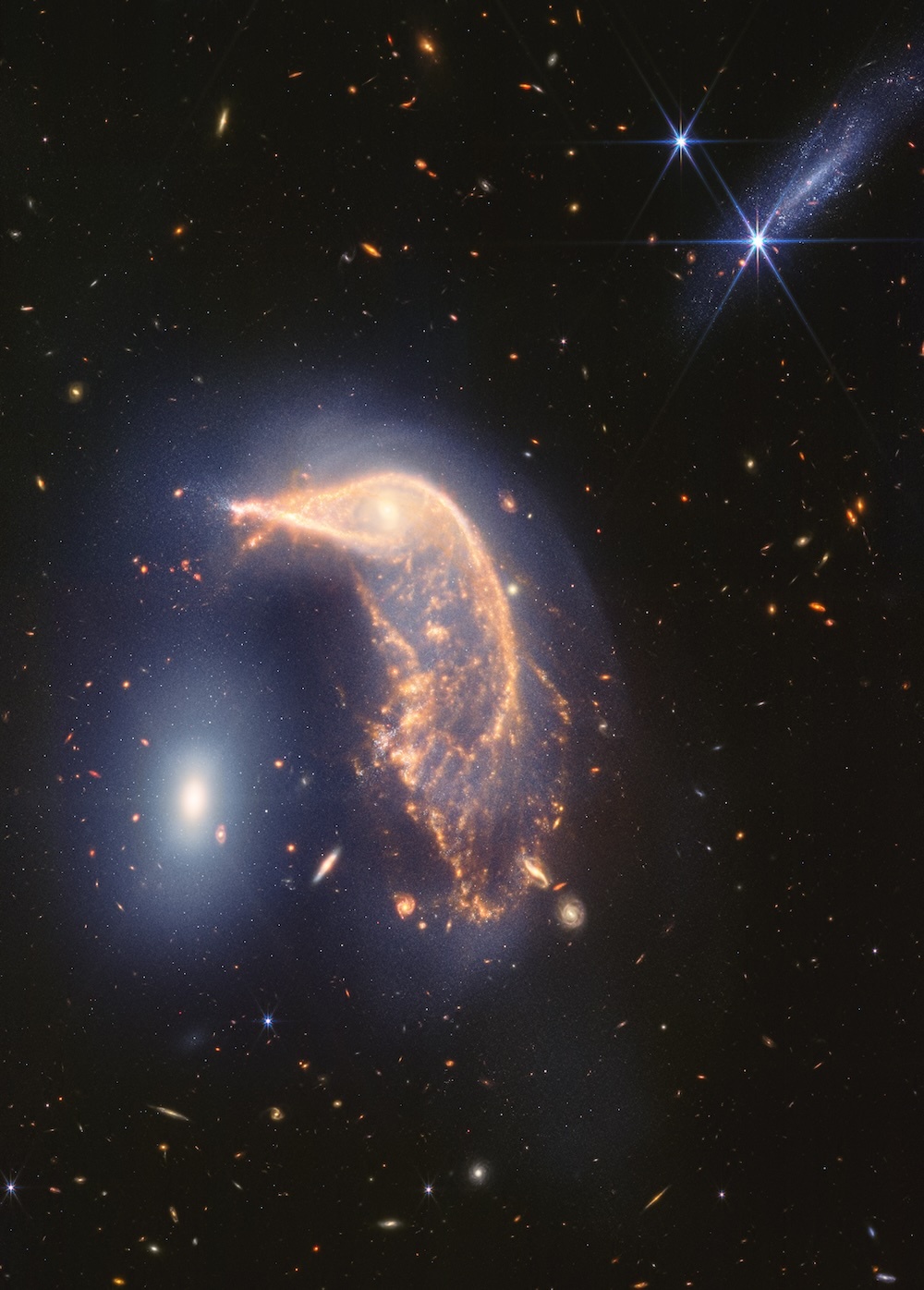14.07.2024

To celebrate the second science anniversary of NASA’s James Webb Space Telescope, the team has released a near- and mid-infrared image on July 12, 2024, of two interacting galaxies: The Penguin and the Egg.
Webb specializes in capturing infrared light – which is beyond what our own eyes can see – allowing us to view and study these two galaxies, collectively known as Arp 142. Their ongoing interaction was set in motion between 25 and 75 million years ago, when the Penguin (individually cataloged as NGC 2936) and the Egg (NGC 2937) completed their first pass. They will go on to shimmy and sway, completing several additional loops before merging into a single galaxy hundreds of millions of years from now.
Quelle: NASA
+++
Before their first approach, the Penguin held the shape of a spiral. Today, its galactic centergleams like an eye, its unwound arms now shaping a beak, head, backbone, and fanned-out tail.
Like all spiral galaxies, the Penguin is still very rich in gas and dust. The galaxies’ “dance” gravitationally pulled on the Penguin’s thinner areas of gas and dust, causing them to crash in waves and form stars. Look for those areas in two places: what looks like a fish in its “beak” and the “feathers” in its “tail.”
Surrounding these newer stars is smoke-like material that includes carbon-containing molecules, known as polycyclic aromatic hydrocarbons, which Webb is exceptional at detecting. Dust, seen as fainter, deeper orange arcs also swoops from its beak to tail feathers.
In contrast, the Egg’s compact shape remains largely unchanged. As an elliptical galaxy, it is filled with aging stars, and has a lot less gas and dust that can be pulled away to form new stars. If both were spiral galaxies, each would end the first “twist” with new star formation and twirling curls, known as tidal tails.
Another reason for the Egg’s undisturbed appearance: These galaxies have approximately the same mass or heft, which is why the smaller-looking elliptical wasn’t consumed or distorted by the Penguin.
It is estimated that the Penguin and the Egg are about 100,000 light-years apart — quite close in astronomical terms. For context, the Milky Way galaxy and our nearest neighbor, the Andromeda Galaxy, are about 2.5 million light-years apart. They too will interact, but not for about 4 billion years.
Now, look to the top right to spot a galaxy that is not at this party. This edge-on galaxy, cataloged PGC 1237172, is 100 million light-years closer to Earth. It’s also quite young, teeming with new, blue stars.
Want one more party trick? Switch to Webb’s mid-infrared-only image to see PGC 1237172 practically disappear. Mid-infrared light largely captures cooler, older stars and an incredible amount of dust. Since the galaxy’s stellar population is so young, it “vanishes” in mid-infrared light.
Image B: Interacting Galaxies Arp 142 (MIRI Only)

Also take a moment to scan the background. Webb’s image is overflowing with distant galaxies. Some take spiral and oval shapes, like those threaded throughout the Penguin’s “tail feathers,” while others scattered throughout are shapeless dots. This is a testament to the sensitivity and resolution of the telescope’s infrared instruments. (Compare Webb’s view to the 2018 observation that combines infrared light from NASA’s retired Spitzer Space Telescope and near-infrared and visible light from NASA’s Hubble Space Telescope.) Even though these observations only took a few hours, Webb revealed far more distant, redder, and dustier galaxies than previous telescopes – one more reason to expect Webb to continue to expand our understanding of everything in the universe.
Want more? Take a tour to the image, “fly through” it in a visualization, and compare Webb’s image to the Hubble Space Telescope’s.
Arp 142 lies 326 million light-years from Earth in the constellation Hydra.
Video: Tour the Arp 142 Image
Credit: NASA, ESA, CSA, STScI, Danielle Kirshenblat (STScI)
